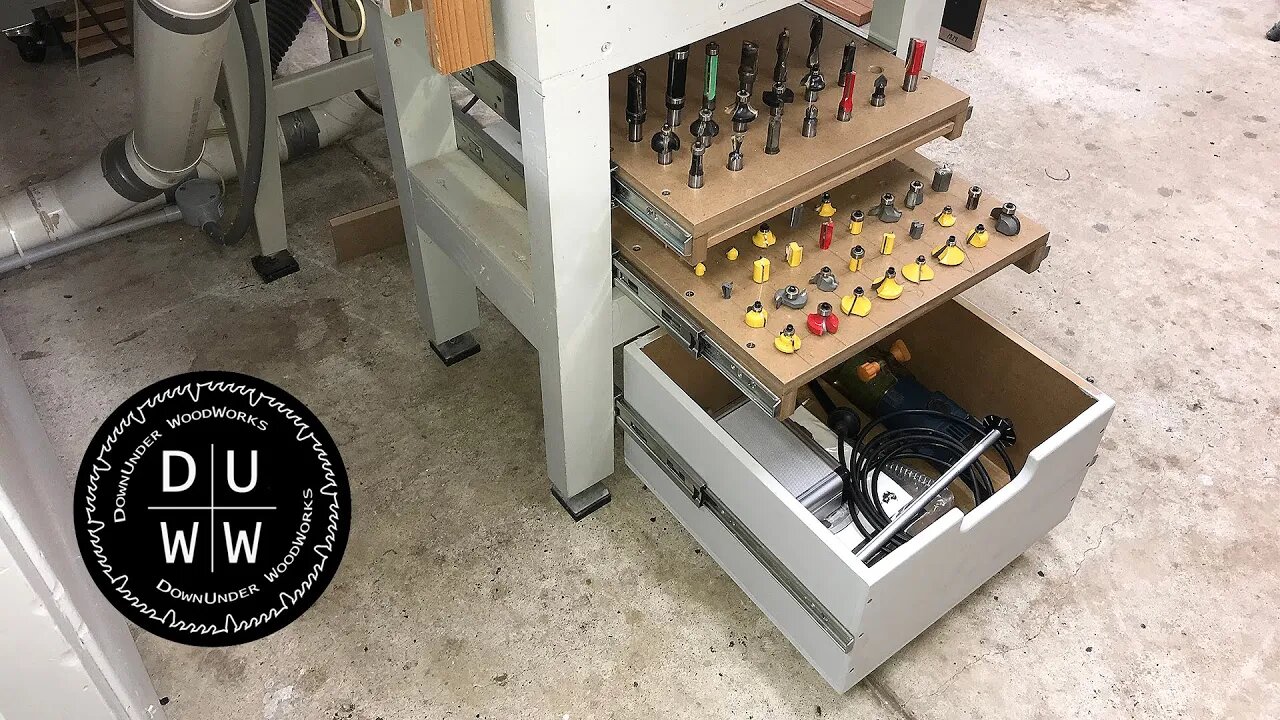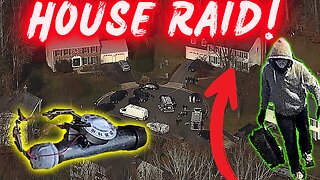Premium Only Content

How to make router bit storage trays
In this video, I utilise some unused space in the base of my router table to make some pullout trays for router bits and a drawer for other related stuff.
My email: [email protected]
T-shirts: https://duww.threadless.com
Stickers: https://www.redbubble.com/people/DUWW
Instagram: https://www.instagram.com/downunderwoodworks/
Video transcript:
Yeah, I think it's about time I made that router bit drawer to go in right about there.
G'day, welcome to Downunder Woodworks. So in today's video, I'm going to show you how I added some much needed storage to what was a basically wasted, unused space in my router table. This is just a raw utilitarian upgrade to the router table so no need for anything fancy or pretty. I started by cutting down the pieces for the bit trays out of 16 mm
MDF. Each tray has the top piece and two side pieces for the drawer runners.
So, I've got that tray cut to size and as you can see with all the router bits placed on it, there's no way one's enough so I'm definitely going to have to make two. I marked out a grid on each tray according to the size of the bits I had so some of
the holes were spaced further apart than others. This is the tray for all my quarter inch bits. Drilling these holes was a bit tedious. I only drilled enough holes for the bits I had at this time. I can always add more later. I used a marking gauge to mark the centreline for the screws to fix the sides to the underneath of the tray. It's absolutely essential to drill pilot
holes whenever screwing into the edge of MDF to stop it from splitting and it's
also, a good idea to stay away from the ends. The holes in the tray then get
drilled out as clearance holes for the screws.
Some of the straight router bits are the same size as the shank and fell through the holes so I added a piece of 6 mm MDF to the underside of a couple of the rows to stop them going all the way through. I made the tray for the half inch bits the same way and because
I had many more straight bits that were falling through the holes I added a
larger board to the underside of this tray. While the trays were glueing up I got to installing the drawer runners. The lower runners were placed directly under
that existing shelf which made lining them up easy. I used some pieces of 6mm MDF to space the tray off the bottom and then screwed the drawer runners in place.
I was pretty impressed with how I built the router table originally because the four legs were all parallel and square so no adjustment was needed to make the runners operate smoothly.
I used a spacer to fix the top runners in place so they would be at exactly the
same level without having to measure anything. It was pretty tight working in
this small space.
To save my knees and back I fixed the inside runner section to the top tray by marking the centreline with a marking gauge and installed the runners flush with the front of the tray. With the bit trays completed, I started on a very basic drawer for the bottom section. The
drawer was made from 12 mm MDF with glued and screwed butt joints and a 12 mm ply
bottom glued and nailed on. As I said before, it's essential to drill pilot holes when screwing into the edge of MDF.
I used a standard drill bit in my drill press with the depth stop set, to countersink the screw holes.
The rest of the drawer construction was pretty much the same. I made a very simple drawer pull on the front of the draw by cutting out a section at the top to get your hand into. I drilled these Forstner bit holes from both sides to eliminate the massive blowout that would have happened if I drilled them through from one side only. After that, I cut out
the waste piece and cleaned it up with a file and
sandpaper and then gave it a nice round over so it was soft to the touch.
The inside of the drawer got a coat of clear poly as did the bit trays and the outside of the drawer was painted workshop grey.
As I mentioned, this was a very utilitarian upgrade so I wasn't concerned with trying to cover up the drawer runners or those screw holes on the outside of the drawer. It still worked
exactly the same.
Well, that worked out really well. I'm really happy with how much storage I was able to squeeze into that small space. I think we all struggle with space in our workshops so it's a good idea to take a look around and maybe reconsider the potential of all those small empty spaces that you might have around.
Well, thanks for watching through to the end of the video and hopefully you've got some good ideas out of this one. If you want to know what I'm up to in between videos you can follow me on Instagram. If you haven't done so already I do invite you to subscribe to the channel but until the next one, you guys all have a great day.
-
 1:07:12
1:07:12
The Rubin Report
3 hours agoHost Gets Visibly Angry as Scott Bessent Rips Him to Shreds in Front of NY Times Crowd
46.9K15 -
 4:42
4:42
Buddy Brown
3 hours agoThe Most GHETTO Chick-fil-A Customer EVER! | Buddy Brown
5.07K7 -
 1:11:14
1:11:14
iCkEdMeL
2 hours ago $1.21 earned🔴 BREAKING: Brian Cole Identified as DC Pipe Bomb Suspect — FBI Arrest
22.1K11 -
 LIVE
LIVE
LFA TV
16 hours agoLIVE & BREAKING NEWS! | THURSDAY 12/04/25
2,781 watching -
 LIVE
LIVE
TheAlecLaceShow
1 hour agoAlec Goes To Capitol Hill for RSC New Media Event | Full Coverage | The Alec Lace Show
33 watching -
 59:25
59:25
VINCE
4 hours agoFINALLY: Jan 6th Pipe Bomber Arrested? | Episode 181 - 12/04/25 VINCE
237K190 -
 1:11:54
1:11:54
Chad Prather
3 hours agoCandace Owens ACCEPTS TPUSA’s Debate Invitation + Dem Rep Instructs Military To REMOVE Trump?!
56.8K14 -
 1:07:17
1:07:17
Grant Stinchfield
2 hours agoBiden’s Inner Circle Cracks! It's the Presidency That Wasn’t!
10.3K3 -
 1:32:47
1:32:47
Graham Allen
5 hours agoCandace Owens vs TPUSA! It’s Time To End This Before It Destroys Everything Charlie Fought For!
150K563 -
 2:02:57
2:02:57
Badlands Media
12 hours agoBadlands Daily: 12/4/25 – Biden’s Pipe Bomb Narrative, Pentagon Chaos, and the Race to Control the Story
56.7K12